|
|
|
Sort Order |
|
|
|
Items / Page
|
|
|
|
|
|
|
| Srl | Item |
| 1 |
ID:
125602


|
|
|
|
|
| Publication |
2013.
|
| Summary/Abstract |
Despite considerable quantitative case study research on communities living with turbines, few have studied the roles played by the perceptions of: health risk, economic benefits/fairness, and intra-community conflict. We report the findings from a case-control survey which compares residents living with/without turbines in their community to understand the relative importance of these variables as predictors of turbine support. Ontario is the context for this study as it is a place where the pace of turbine installations is both very high and extremely politicized. As expected 69% of residents in the case community would vote in favour of local turbines yet surprisingly, only 25% would do so in the control community. Though the literature suggests that aesthetic preferences best predict turbine support the key predictors in this study are: health risk perception, community benefits, general community enhancement, and a preference for turbine-generated electricity. Concern about intra-community conflict is high in both the case (83%) and control (85%) communities as is concern about the fairness of local economic benefits (56% and 62%, respectively); yet neither is significant in the models. We discuss the implications of these findings particularly in terms of the consequences of a technocratic decide-announce-defend model of renewable facility siting.
|
|
|
|
|
|
|
|
|
|
|
|
|
|
|
|
| 2 |
ID:
117311
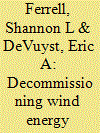

|
|
|
|
|
| Publication |
2013.
|
| Summary/Abstract |
Wind energy is the fastest-growing segment of new electrical power capacity in the United States, with the potential for significant growth in the future. To facilitate such growth, a number of concerns between developers and landowners must be resolved, including assurance of wind turbine decommissioning at the end of their useful lives. Oklahoma legislators enlisted the authors to develop an economically-sound proposal to ensure developers complete their decommissioning obligations. Economic analysis of turbine decommissioning is complicated by a lack of operational experience, as few U.S. projects have been decommissioned. This leads to a lack of data regarding decommissioning costs. Politically, the negotiation leading to the finally-enacted solution juxtaposed economic theory against political pragmatism, leading to a different but hopefully sound solution. This article will provide background for the decommissioning issue, chronicle the development of the decommissioning component of the Oklahoma Wind Energy Act, and frame issues that remain for policymakers in regulating wind power development.
|
|
|
|
|
|
|
|
|
|
|
|
|
|
|
|
| 3 |
ID:
127215
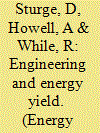

|
|
|
|
|
| Publication |
2014.
|
| Summary/Abstract |
The goal of optimising the energy yield of renewables sits uneasily with the politics and processes of planning for wind turbines. In countries such as the UK the land-use planning consent regime is not concerned with the energy yield of proposed wind developments. This is a matter for the developer rather than the regulator, which might seem curious given the policy commitment to maximising the potential for renewable energy generation and the need to weigh up local environmental impacts with emissions reduction. In this paper, we highlight and investigate the implications of the exclusion of energy yield from wind turbine regulation. The case is made for increasing the weight given to energy yield within Environmental Impact Assessment and the land-use planning process.
|
|
|
|
|
|
|
|
|
|
|
|
|
|
|
|
| 4 |
ID:
150786
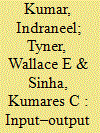

|
|
|
|
|
| Summary/Abstract |
Wind energy is an emerging source for renewable energy. This article presents an application of the economic input–output life cycle assessment (EIO-LCA) to estimate the greenhouse gas (GHG) emissions through the life cycle of wind energy farms in a state. The EIO-LCA incorporates manufacturing, installation, operation and maintenance, and decommissioning of the wind turbine over its life cycle period. In doing so, the study demonstrates that O&M and decommissioning of infrastructure with a longer life period can be considered to assess the total environmental impacts. The life cycle costs of wind turbine installation in Indiana is used in this study. The uncertainty in wind energy production, and hence the variability in GHG emission intensities in metric tons per gigawatt hour (GWh), is demonstrated by using the Monte Carlo simulation. The research finds that wind energy production is not entirely GHG emission-free if all the costs and life cycle stages are considered. Emission estimates have uncertainty, and O&M and decommissioning can add up to 200 metric tons of GHG emissions in CO2e per wind turbine life cycle. The regional EIO-LCA can be a helpful tool to determine strategies for state compliance to initiatives, such as the Clean Power Plan.
|
|
|
|
|
|
|
|
|
|
|
|
|
|
|
|
| 5 |
ID:
112892
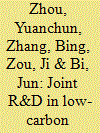

|
|
|
|
|
| Publication |
2012.
|
| Summary/Abstract |
China faces the dual challenges of climate change and increased energy demand. These challenges in turn increase the demand for wind energy development. Along with rapid growth in manufacturing capacity, Chinese companies have aspired to increase their innovation capacity in order to enhance their competitiveness in the market. Joint research and development (R&D) is an attractive path for Chinese companies striving to advance their R&D capacity. This paper examines joint R&D between Chinese wind-turbine manufacturing companies and foreign design firms, assessing the performance of joint R&D activities in China using the structure-conduct-performance (SCP) framework. The study found that joint R&D has improved Chinese companies' technical capacity, human resources and financial growth. However, the effect on Chinese companies' innovation capacity is still limited because of unequal technical capacities of the two sides in collaboration, as well as their preference for augmenting profits rather than technical capacity. Current joint R&D mode is only the extension of licensing mode in wind-turbine manufacturing industry.
|
|
|
|
|
|
|
|
|
|
|
|
|
|
|
|
| 6 |
ID:
125694


|
|
|
|
|
| Publication |
2013.
|
| Summary/Abstract |
Wind turbines produce sound during their operation; therefore, jurisdictions around the world have developed regulations regarding the placement of electricity generating wind farms with the intent of preventing unacceptable levels of 'community noise' in their vicinity. However, as survey results indicate that the relationship between wind turbine noise and annoyance may differ from noise-annoyance relationships for other common noise sources (e.g., rail, traffic), there are concerns that the application of general noise guidelines for wind turbines may lead to unacceptably high levels of annoyance in communities. In this study, previously published survey results that quantified wind turbine noise and self-reported annoyance were applied to the predicted noise levels (from turbines and transformers) for over 8000 receptors in the vicinity of 13 planned wind power developments in the province of Ontario, Canada. The results of this analysis indicate that the current wind turbine noise restrictions in Ontario will limit community exposure to wind turbine related noise such that levels of annoyance are unlikely to exceed previously established background levels of noise-related annoyance from other common noise sources. This provides valuable context that should be considered by policy-makers when evaluating the potential impacts of wind turbine noise on the community.
|
|
|
|
|
|
|
|
|
|
|
|
|
|
|
|
| 7 |
ID:
166495
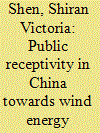

|
|
|
|
|
| Summary/Abstract |
China leads the world's wind energy market, but little has been written about public receptivity towards wind energy generators in China. To fill this gap, we pursue a survey experimental approach to examine explanations for receptivity based on evidence from OECD countries as well as the importance of public knowledge in augmenting public acceptance of wind energy generators in China. We find that Chinese respondents are sensitive to siting near their residences, to cost considerations when imposed on them directly, to wildlife externalities, and to noise from turbines. Interestingly, Chinese respondents seem to be concerned about radiation, a finding unprecedented in the literature, and are less assured by scientific assurances that radiation is not a problem. Instead, the Chinese central government is best suited to address concerns about this topic. Targeted information provision to the public can improve public knowledge about aspects of wind energy of concern. Hence, the Chinese central government can promote wind energy deployment not just because it is an authoritarian government determined to get things done, but also because it can provide relevant information to reduce potential public resistance.
|
|
|
|
|
|
|
|
|
|
|
|
|
|
|
|
| 8 |
ID:
127220
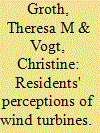

|
|
|
|
|
| Publication |
2014.
|
| Summary/Abstract |
Wind energy development has become a 'hot topic' across Michigan as this state seeks to achieve 10% of energy delivered to consumers from renewable sources (Huron County Planning Commission, 2005). The focus of this effort to generate renewable energy has centered around wind energy. Wind turbines have been constructed at numerous locations across the state. The lower peninsulas' eastern counties near Lake Huron and Saginaw Bay were designated by the Wind Energy Resource Zone board as one such area of strong sustained wind in the state. Turbines have been constructed in 'pockets' across this 'thumb' region, yet half a decade after the first turbines were constructed, negative perceptions are still attributed to wind turbines. This paper examines residents of wind farm locations as a whole and independently as groups (those in opposition and in support of development) to identify what, if any similarities and differences, exist between the residents' perceptions. Qualitative analysis on stated negative perceptions unveiled common issues with residents: increased price of electricity with wind energy, noise from the turbine rotation and uncertainty surrounding the long term effects of wind turbines. These areas of concern seem to persist years after construction was completed.
|
|
|
|
|
|
|
|
|
|
|
|
|
|
|
|
|
|
|
|
|